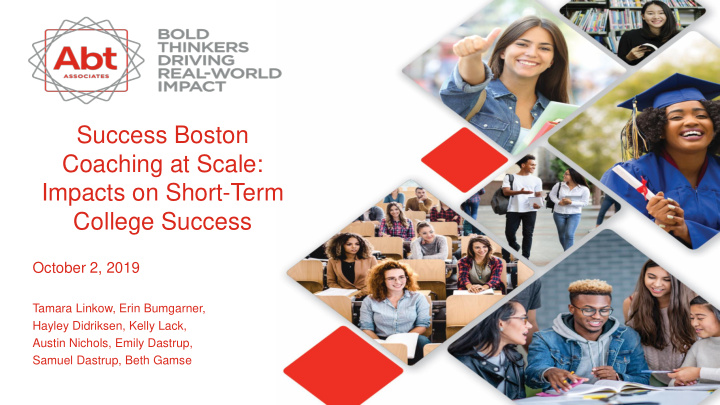



Success Boston Coaching at Scale: Impacts on Short-Term College Success October 2, 2019 Tamara Linkow, Erin Bumgarner, Hayley Didriksen, Kelly Lack, Austin Nichols, Emily Dastrup, Samuel Dastrup, Beth Gamse
Policy Context Jobs that require a BA continue to increase at a higher pace than any other educational level About half (52%) of Boston’s 2011 public high school graduates who enrolled in college graduated within 6 years Low-income students, first-generation students, and racial/ethnic minorities are underrepresented in postsecondary education
Citywide collaboration among the Boston Foundation, Boston Public Schools, City of Boston, local nonprofits, and local colleges to support college completion Promote evidence-based practices to help students succeed in higher education and prepare to enter workforce Core component is transition support to Boston high school graduates enrolling in local 2-year and 4-year colleges 3
Success Boston Coaching Model 4
Coaching Intensity One-on-one coach-student interactions in 2015-16 Average number: 6 Number of interactions vary by student — most students met with coach at least once per semester Typical length: 34 minutes One-on-one interactions tended to last between 25 and 45 minutes Average of one-on-one coaching per year= 3.5 hours
Scaling Up In fall 2015, Boston Coaching for Completion (BosC4C) expanded reach of SBC program with Social Innovation Fund grant funding from Corporation for National and Community Service 6
Who SBC Serves Students are from groups too often under-represented in postsecondary education • 93% identify as non-white • 48% are economically disadvantaged • 2.46 average GPA 7
Research Questions Overall Impacts: Differences in Impacts : What is the effect of Success How, if at all, do the impacts Boston coaching on student of Success Boston coaching success in college? differ by student characteristics and features of the coaching? 8
Analysis Approach First two cohorts of scale up, entering college in 2015 and 2016 Quasi-experimental design SBC students matched with similar non-coached students: Same cohort Graduated from similar high schools Enrolled in the same college Share similar academic and background characteristics 9
Outcomes • College persistence into 2 nd and 3 rd years • Full-time status • Cumulative GPA • Credit accumulation • Non-credit bearing courses • FAFSA Renewal 10
Data Sources 11 Boston area Program Database colleges 11
Persistence into 2 nd and 3 rd Years 78.3 } 4.3* Persistence into the 2nd Year 82.6 } 2.8 71.9 Persistence into the 3rd Year 74.7 0 20 40 60 80 100 Percentage of Students Adjusted Comparison Treatment Group Mean Group Mean * Impact is significant at the 5 percent level
Full-time Enrollment 63.6 } 3.7* Full-Time Status 67.3 0 20 40 60 80 100 Percentage of Semesters Adjusted Comparison Treatment Group Mean Group Mean * Impact is significant at the 5 percent level
Cumulative GPA 2.36 } 0.01 Cumulative GPA 2.37 0 1 2 3 4 Grade Point Average (GPA) Adjusted Comparison Group Mean Treatment Group Mean * Impact is significant at the 5 percent level
Non-Credit Bearing Courses 0.65 Semesters Enrolled in } 0.03 Non-Credit Bearing Courses 0.67 0 1 2 3 4 Number of Semesters Adjusted Comparison Group Mean Treatment Group Mean * Impact is significant at the 5 percent level
Credit Accumulation 42.5 } 3.1* Credit Accumulation 45.5 0 20 40 60 80 100 Percentage of Credits Adjusted Comparison Group Mean Treatment Group Mean * Impact is significant at the 5 percent level
FAFSA Renewal 77.7 } 6.2* FAFSA renewal 83.9 0 20 40 60 80 100 Percentage of Students Adjusted Comparison Group Mean Treatment Group Mean * Impact is significant at the 5 percent level
Differences in Impacts by Student Characteristics Examined differences in coaching impacts by student characteristics Gender Underrepresented minority status High school GPA Two vs. four-year college attendance No consistent patterns found Study Design
Differences in Impacts by Frequency of Coaching 15 * 13.3 * High 11.9 * 10.9 Low 10 5 2.9 * 0.16 0 -0.10 -1.6 -2.0 -5 Persistence into 2nd Persistence into 3rd Cumulative GPA FAFSA Renewal Year of College Year of College * Impact is significant at the 5 percent level 19
Summary of Findings Compared to non-coached students, SBC students: Are 5% more likely to persist into the 2nd year of college Are 6% more likely to be enrolled full-time Accumulated 7% more credits toward graduation Are 8% more likely to renew their FAFSAs Impacts are concentrated among students who experience more frequent coach interactions 20
Trends in Student Persistence 100% 2013 and 2014 Coached Students 95% Percentage of Students 2013 and 2014 Comparison Students 90% 2015 and 2016 Coached Students 85% 80% 2015 and 2016 Comparison Students 75% 70% 65% 60% 55% 50% 2nd year of college 3rd year of college 4th year of college Persistence 21
Explaining Trends: Student Support Services Participating colleges often provide multiple non- academic support services: Resource centers that assist with non-academic needs like childcare, housing, and food Coaching and peer mentoring focused on supporting first-year students and underrepresented minorities Skills workshops and group seminars to help students develop personal competencies 22
Next Steps Add additional cohort of students who entered college in the fall of 2017 Follow students for up to 6 years after college entrance Focus on degree/credential completion Next reports scheduled for release in 2021 and 2022 23
Contact Tamara Linkow, Project Director Tamara_Linkow@abtassoc.com 24
Recommend
More recommend